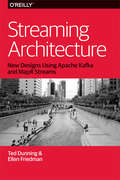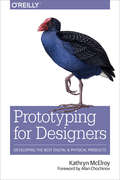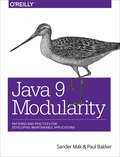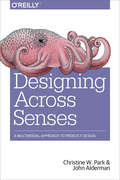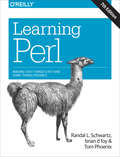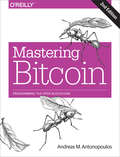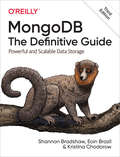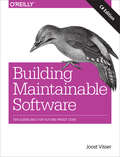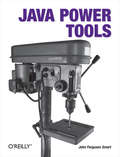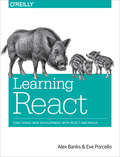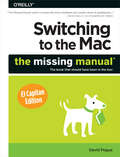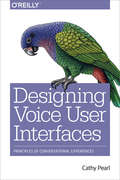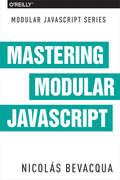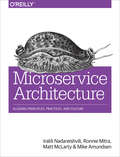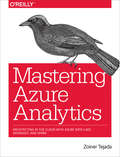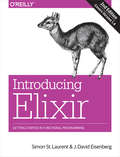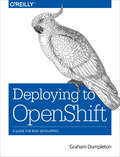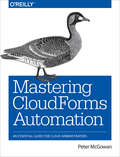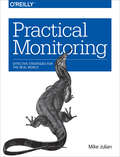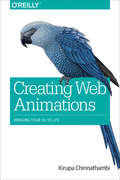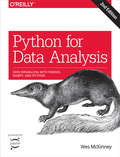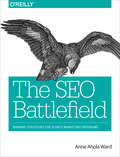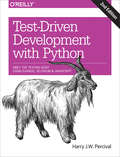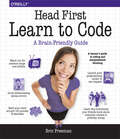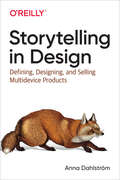- Table View
- List View
Streaming Architecture: New Designs Using Apache Kafka and MapR Streams
by Ellen Friedman Ted DunningMore and more data-driven companies are looking to adopt stream processing and streaming analytics. With this concise ebook, you'll learn best practices for designing a reliable architecture that supports this emerging big-data paradigm.Authors Ted Dunning and Ellen Friedman (Real World Hadoop) help you explore some of the best technologies to handle stream processing and analytics, with a focus on the upstream queuing or message-passing layer. To illustrate the effectiveness of these technologies, this book also includes specific use cases.Ideal for developers and non-technical people alike, this book describes:Key elements in good design for streaming analytics, focusing on the essential characteristics of the messaging layerNew messaging technologies, including Apache Kafka and MapR Streams, with links to sample codeTechnology choices for streaming analytics: Apache Spark Streaming, Apache Flink, Apache Storm, and Apache ApexHow stream-based architectures are helpful to support microservicesSpecific use cases such as fraud detection and geo-distributed data streamsTed Dunning is Chief Applications Architect at MapR Technologies, and active in the open source community. He currently serves as VP for Incubator at the Apache Foundation, as a champion and mentor for a large number of projects, and as committer and PMC member of the Apache ZooKeeper and Drill projects. Ted is on Twitter as @ted_dunning.Ellen Friedman, a committer for the Apache Drill and Apache Mahout projects, is a solutions consultant and well-known speaker and author, currently writing mainly about big data topics. With a PhD in Biochemistry, she has years of experience as a research scientist and has written about a variety of technical topics. Ellen is on Twitter as @Ellen_Friedman.
Prototyping for Designers: Developing the Best Digital and Physical Products
by Kathryn McelroyPrototyping and user testing is the best way to create successful products, but many designers skip this important step and use gut instinct instead. By explaining the goals and methodologies behind prototyping—and demonstrating how to prototype for both physical and digital products—this practical guide helps beginning and intermediate designers become more comfortable with creating and testing prototypes early and often in the process.Author Kathryn McElroy explains various prototyping methods, from fast and dirty to high fidelity and refined, and reveals ways to test your prototypes with users. You’ll gain valuable insights for improving your product, whether it’s a smartphone app or a new electronic gadget.Learn similarities and differences between prototyping for physical and digital productsKnow what fidelity level is needed for different prototypesGet best practices for prototyping in a variety of mediums, and choose which prototyping software or components to useLearn electronics prototyping basics and resources for getting startedWrite basic pseudocode and translate it into usable code for ArduinoConduct user tests to gain insights from prototypes
Java 9 Modularity: Patterns and Practices for Developing Maintainable Applications
by Sander Mak Paul BakkerThe upcoming Java 9 module system will affect existing applications and offer new ways of creating modular and maintainable applications. With this hands-on book, Java developers will learn not only about the joys of modularity, but also about the patterns needed to create truly modular and reliable applications. Authors Sander Mak and Paul Bakker teach you the concepts behind the Java 9 module system, along with the new tools it offers. You’ll also gain learn how to modularize existing code and how to build new Java applications in a modular way.Understand Java 9 module system conceptsMaster the patterns and practices for building truly modular applicationsMigrate existing applications and libraries to Java 9 modulesUse JDK 9 tools for modular development and migration
Designing Across Senses: A Multimodal Approach to Product Design
by John Alderman Christine W. ParkToday we have the ability to connect speech, touch, haptic, and gestural interfaces into products that engage several human senses at once. This practical book explores examples from current designers and devices to describe how these products blend multiple interface modes together into a cohesive user experience.Authors Christine Park and John Alderman explain the basic principles behind multimodal interaction and introduce the tools you need to root your design in the ways our senses shape experience. This book also includes guides on process, design, and deliverables to help your team get started.The book covers several topics within multimodal design, including:New Human Factors: learn how human sensory abilities allow us to interact with technology and the physical worldNew Technologies: explore some of the technologies that enable multimodal interactions, products, and capabilitiesMultimodal Products: examine different categories of products and learn how they deliver sensory-rich experiencesMultimodal Design: learn processes and methodologies for multimodal product design, development, and release
Learning Perl: Making Easy Things Easy and Hard Things Possible (In a Nutshell)
by Randal L. Schwartz Tom Phoenix Brian D FoyIf you're just getting started with Perl, this is the book you want--whether you're a programmer, system administrator, or web hacker. Nicknamed "the Llama" by two generations of users, this bestseller closely follows the popular introductory Perl course taught by the authors since 1991. This seventh edition covers recent changes to the language up to version 5.24.Perl is suitable for almost any task on almost any platform, from short fixes to complete web applications. Learning Perl teaches you the basics and shows you how to write programs up to 128 lines long--roughly the size of 90% of the Perl programs in use today. Each chapter includes exercises to help you practice what you've just learned. Other books may teach you to program in Perl, but this book will turn you into a Perl programmer.Topics include:Perl data and variable typesSubroutinesFile operationsRegular expressionsString manipulation (including Unicode)Lists and sortingProcess managementSmart matchingUse of third party modules
Mastering Bitcoin: Programming the Open Blockchain
by Andreas M. AntonopoulosJoin the technological revolution that’s taking the financial world by storm. Mastering Bitcoin is your guide through the seemingly complex world of bitcoin, providing the knowledge you need to participate in the internet of money. Whether you’re building the next killer app, investing in a startup, or simply curious about the technology, this revised and expanded second edition provides essential detail to get you started.Bitcoin, the first successful decentralized digital currency, is still in its early stages and yet it’s already spawned a multi-billion-dollar global economy open to anyone with the knowledge and passion to participate. Mastering Bitcoin provides the knowledge. You simply supply the passion.The second edition includes:A broad introduction of bitcoin and its underlying blockchain—ideal for non-technical users, investors, and business executivesAn explanation of the technical foundations of bitcoin and cryptographic currencies for developers, engineers, and software and systems architectsDetails of the bitcoin decentralized network, peer-to-peer architecture, transaction lifecycle, and security principlesNew developments such as Segregated Witness, Payment Channels, and Lightning NetworkA deep dive into blockchain applications, including how to combine the building blocks offered by this platform into higher-level applicationsUser stories, analogies, examples, and code snippets illustrating key technical concepts
MongoDB: Powerful and Scalable Data Storage
by Shannon Bradshaw Eoin Brazil Kristina ChodorowManage your data with a system designed to support modern application development. Updated for MongoDB 4.2, the third edition of this authoritative and accessible guide shows you the advantages of using document-oriented databases. You’ll learn how this secure, high-performance system enables flexible data models, high availability, and horizontal scalability.Authors Shannon Bradshaw, Eoin Brazil, and Kristina Chodorow provide guidance for database developers, advanced configuration for system administrators, and use cases for a variety of projects. NoSQL newcomers and experienced MongoDB users will find updates on querying, indexing, aggregation, transactions, replica sets, ops management, sharding and data administration, durability, monitoring, and security.In six parts, this book shows you how to:Work with MongoDB, perform write operations, find documents, and create complex queriesIndex collections, aggregate data, and use transactions for your applicationConfigure a local replica set and learn how replication interacts with your applicationSet up cluster components and choose a shard key for a variety of applicationsExplore aspects of application administration and configure authentication and authorizationUse stats when monitoring, back up and restore deployments, and use system settings when deploying MongoDB
Building Maintainable Software (C# Edition): Ten Guidelines for Future-Proof Code
by Gijs Wijnholds Joost Visser Pascal Van Eck Rob van der Leek Sylvan RigalHave you ever felt frustrated working with someone else’s code? Difficult-to-maintain source code is a big problem in software development today, leading to costly delays and defects. Be part of the solution. With this practical book, you’ll learn 10 easy-to-follow guidelines for delivering C# software that’s easy to maintain and adapt. These guidelines have been derived from analyzing hundreds of real-world systems.Written by consultants from the Software Improvement Group (SIG), this book provides clear and concise explanations, with advice for turning the guidelines into practice. Examples for this edition are written in C#, while our companion Java book provides clear examples in that language.Write short units of code: limit the length of methods and constructorsWrite simple units of code: limit the number of branch points per methodWrite code once, rather than risk copying buggy codeKeep unit interfaces small by extracting parameters into objectsSeparate concerns to avoid building large classesCouple architecture components looselyBalance the number and size of top-level components in your codeKeep your codebase as small as possibleAutomate tests for your codebaseWrite clean code, avoiding "code smells" that indicate deeper problems
Java Power Tools
by John Ferguson SmartAll true craftsmen need the best tools to do their finest work, and programmers are no different. Java Power Tools delivers 30 open source tools designed to improve the development practices of Java developers in any size team or organization. Each chapter includes a series of short articles about one particular tool -- whether it's for build systems, version control, or other aspects of the development process -- giving you the equivalent of 30 short reference books in one package.No matter which development method your team chooses, whether it's Agile, RUP, XP, SCRUM, or one of many others available, Java Power Tools provides practical techniques and tools to help you optimize the process. The book discusses key Java development problem areas and best practices, and focuses on open source tools that can help increase productivity in each area of the development cycle, including:Build tools including Ant and Maven 2Version control tools such as CVS and Subversion, the two most prominent open source toolsQuality metrics tools that measure different aspects of code quality, including CheckStyle, PMD, FindBugs and JupiterTechnical documentation tools that can help you generate good technical documentation without spending too much effort writing and maintaining itUnit Testing tools including JUnit 4, TestNG, and the open source coverage tool CoberturaIntegration, Load and Performance Testing to integrate performance tests into unit tests, load-test your application, and automatically test web services, Swing interfaces and web interfacesIssue management tools including Bugzilla and TracContinuous Integration tools such as Continuum, Cruise Control, LuntBuild and HudsonIf you are a Java developer, these tools can help improve your development practices, and make your life easier in the process. Lead developers, software architects and people interested in the wider picture will be able to gather from these pages some useful ideas about improving your project infrastructure and best practices.
Learning React: Functional Web Development with React and Redux
by Alex Banks Eve PorcelloIf you want to learn how to build efficient user interfaces with React, this is your book. Authors Alex Banks and Eve Porcello show you how to create UIs with this small JavaScript library that can deftly display data changes on large-scale, data-driven websites without page reloads. Along the way, you’ll learn how to work with functional programming and the latest ECMAScript features.Developed by Facebook, and used by companies including Netflix, Walmart, and The New York Times for large parts of their web interfaces, React is quickly growing in use. By learning how to build React components with this hands-on guide, you’ll fully understand how useful React can be in your organization.Learn key functional programming concepts with JavaScriptPeek under the hood to understand how React runs in the browserCreate application presentation layers by mounting and composing React componentsUse component trees to manage data and reduce the time you spend debugging applicationsExplore React’s component lifecycle and use it to load data and improve UI performanceUse a routing solution for browser history, bookmarks, and other features of single-page applicationsLearn how to structure React applications with servers in mind
Switching to the Mac: The Missing Manual, El Capitan Edition
by David PogueThose who have made the switch from a Windows PC to a Mac have made Switching to the Mac: The Missing Manual a runaway bestseller. The latest edition of this guide delivers what Apple doesn't--everything you need to know to successfully and painlessly move your files and adapt to Mac's way of doing things. Written with wit and objectivity by Missing Manual series creator and bestselling author David Pogue, this book will have you up and running on your new Mac in no time.
Designing Voice User Interfaces: Principles of Conversational Experiences
by Cathy PearlVoice user interfaces (VUIs) are becoming all the rage today. But how do you build one that people can actually converse with? Whether you’re designing a mobile app, a toy, or a device such as a home assistant, this practical book guides you through basic VUI design principles, helps you choose the right speech recognition engine, and shows you how to measure your VUI’s performance and improve upon it.Author Cathy Pearl also takes product managers, UX designers, and VUI designers into advanced design topics that will help make your VUI not just functional, but great.Understand key VUI design concepts, including command-and-control and conversational systemsDecide if you should use an avatar or other visual representation with your VUIExplore speech recognition technology and its impact on your designTake your VUI above and beyond the basic exchange of informationLearn practical ways to test your VUI application with usersMonitor your app and learn how to quickly improve performanceGet real-world examples of VUIs for home assistants, smartwatches, and car systems
Mastering Modular JavaScript
by Nicolas BevacquaIf you have a working knowledge of JavaScript and ECMAScript 6 (ES6), this practical guide will help you tackle modular programming to produce code that’s readable, maintainable, and scalable. You’ll learn the fundamentals of modular architecture with JavaScript and the benefits of writing self-contained code at every system level, including the client and server.Nicolás Bevacqua, author of Practical Modern JavaScript, demonstrates how to scale out JavaScript applications by breaking codebases into smaller modules. By following the design practices in this book, senior developers, technical leaders, and software architects will learn how to create modules that are simple and flexible while keeping internal complexity in check.Learn modular design essentials, including how your application will be consumed and what belongs on the interfaceDesign module internals to keep your code readable and its intent clearReduce complexity by refactoring code and containing and eliminating stateTake advantage of modern JavaScript features to write clear programs and reduce complexityApply Twelve-Factor App principles to frontend and backend JavaScript application development
Microservice Architecture: Aligning Principles, Practices, and Culture
by Mike Amundsen Matt Mclarty Irakli Nadareishvili Ronnie MitraMicroservices can have a positive impact on your enterprise--just ask Amazon and Netflix--but you can fall into many traps if you don't approach them in the right way. This practical guide covers the entire microservices landscape, including the principles, technologies, and methodologies of this unique, modular style of system building. You'll learn about the experiences of organizations around the globe that have successfully adopted microservices.In three parts, this book explains how these services work and what it means to build an application the Microservices Way. You'll explore a design-based approach to microservice architecture with guidance for implementing various elements. And you'll get a set of recipes and practices for meeting practical, organizational, and cultural challenges to microservice adoption.Learn how microservices can help you drive business objectivesExamine the principles, practices, and culture that define microservice architecturesExplore a model for creating complex systems and a design process for building a microservice architectureLearn the fundamental design concepts for individual microservicesDelve into the operational elements of a microservices architecture, including containers and service discoveryDiscover how to handle the challenges of introducing microservice architecture in your organization
Mastering Azure Analytics: Architecting in the Cloud with Azure Data Lake, HDInsight, and Spark
by Zoiner TejadaMicrosoft Azure has over 20 platform-as-a-service (PaaS) offerings that can act in support of a big data analytics solution. So which one is right for your project? This practical book helps you understand the breadth of Azure services by organizing them into a reference framework you can use when crafting your own big data analytics solution.You’ll not only be able to determine which service best fits the job, but also learn how to implement a complete solution that scales, provides human fault tolerance, and supports future needs.Understand the fundamental patterns of the data lake and lambda architectureRecognize the canonical steps in the analytics data pipeline and learn how to use Azure Data Factory to orchestrate themImplement data lakes and lambda architectures, using Azure Data Lake Store, Data Lake Analytics, HDInsight (including Spark), Stream Analytics, SQL Data Warehouse, and Event HubsUnderstand where Azure Machine Learning fits into your analytics pipelineGain experience using these services on real-world data that has real-world problems, with scenarios ranging from aviation to Internet of Things (IoT)
Introducing Elixir: Getting Started in Functional Programming
by Simon St. Laurent J. David EisenbergSmooth, powerful, and small, Elixir is an excellent language for learning functional programming, and with this hands-on introduction, you’ll discover just how powerful Elixir can be. Authors Simon St. Laurent and J. David Eisenberg show you how Elixir combines the robust functional programming of Erlang with an approach that looks more like Ruby, and includes powerful macro features for metaprogramming.Updated to cover Elixir 1.4, the second edition of this practical book helps you write simple Elixir programs by teaching one skill at a time. Once you pick up pattern matching, process-oriented programming, and other concepts, you’ll understand why Elixir makes it easier to build concurrent and resilient programs that scale up and down with ease.Get comfortable with IEx, Elixir’s command line interfaceLearn Elixir’s basic structures by working with numbersDiscover atoms, pattern matching, and guards: the foundations of your program structureDelve into the heart of Elixir processing with recursion, strings, lists, and higher-order functionsCreate Elixir processes and send messages among themStore and manipulate structured data with Erlang Term Storage and the Mnesia databaseBuild resilient applications with the Open Telecom Platform
Deploying to OpenShift: A Guide for Busy Developers
by Graham DumpletonGet an in-depth tour of OpenShift, the container-based software deployment and management platform from Red Hat that provides a secure multi-tenant environment for the enterprise. This practical guide describes in detail how OpenShift, building on Kubernetes, enables you to automate the way you create, ship, and run applications in a containerized environment.Author Graham Dumpleton provides the knowledge you need to make the best use of the OpenShift container platform to deploy not only your cloud-native applications, but also more traditional stateful applications. Developers and administrators will learn how to run, access, and manage containers in OpenShift, including how to orchestrate them at scale. Build application container images from source and deploy them; Implement and extend application image builders; Use incremental and chained builds to accelerate build times; Automate builds by using a webhook to link OpenShift to a Git repository; Add configuration and secrets to the container as project resources; Make an application visible outside the OpenShift cluster; Manage persistent storage inside an OpenShift container; Monitor application health and manage the application lifecycle. This book is a perfect follow-up to OpenShift for Developers: A Guide for Impatient Beginners (O’Reilly).
Mastering CloudForms Automation: An Essential Guide for Cloud Administrators
by Peter McgowanLearn how to work with the Automate feature of CloudForms, the powerful Red Hat cloud management platform that lets you administer your virtual infrastructure, including hybrid public and private clouds. This practical hands-on introduction shows you how to increase your operational efficiency by automating day-to-day tasks that now require manual input.Throughout the book, author Peter McGowan provides a combination of theoretical information and practical coding examples to help you learn the Automate object model. With this CloudForms feature, you can create auto-scalable cloud applications, eliminate manual decisions and operations when provisioning virtual machines and cloud instances, and manage your complete virtual machine lifecycle. In six parts, this book helps you:Learn the objects and concepts for developing automation scripts with CloudForms Automate Customize the steps and workflows involved in provisioning virtual machines. Create and use service catalogs, items, dialogs, objects, bundles, and hierarchies. Use CloudForm’s updated workflow to retire and delete virtual machines and services. Orchestrate and coordinate with external services as part of a workflow. Explore distributed automation processing as well as argument passing and handling
Practical Monitoring: Effective Strategies for the Real World
by Mike JulianDo you have a nagging feeling that your monitoring could be improved, but you just aren’t sure how? This is the book for you. Practical Monitoring explains what makes your monitoring less than stellar, and provides a practical approach to designing and implementing a monitoring strategy, from the application down to the hardware in the datacenter and everything in between.In the world of technical operations, monitoring is core to everything you do. In today’s changing landscape of microservices, cloud infrastructure, and more, monitoring is experiencing a new surge of growth, bringing along new methodologies, new ways of thinking, and new tools.Complete with a primer on statistics and a monitoring vocabulary, this book helps you identify the main areas you need to monitor and shows you how to approach them. It’s ideal for operations engineers, system administrators, system and software engineers, site reliability engineers, network engineers, and other operations professionals.
Creating Web Animations: Bringing Your UIs to Life
by Kirupa ChinnathambiThanks to faster browsers, better web standards support, and more powerful devices, the web now defines the next generation of user interfaces that are fun, practical, fluid, and memorable. The key? Animation. But learning how to create animations is hard, and existing learning material doesn’t explain the context of the UI problem that animations are trying to solve. That’s where this book comes in.You'll gain a solid technical understanding of how to create awesome animations using CSS and learn how to implement common UI patterns, using practical examples that rely on animations to solve a core problem. Frontend web developers and designers will not only learn important technical details, but also how to apply them to solve real-world problems.Create animations found in common user interface implementations, such as bounce after scrolling, expanding search boxes, and content slidersLearn the technical details of working with CSS animations and transitionsUse CSS transforms to very animate an element’s position, scale, and orientationUnderstand the importance of easing
Python for Data Analysis: Data Wrangling with Pandas, NumPy, and IPython (Oreilly And Associate Ser.)
by Wes MckinneyGet complete instructions for manipulating, processing, cleaning, and crunching datasets in Python. Updated for Python 3.6, the second edition of this hands-on guide is packed with practical case studies that show you how to solve a broad set of data analysis problems effectively. You’ll learn the latest versions of pandas, NumPy, IPython, and Jupyter in the process.Written by Wes McKinney, the creator of the Python pandas project, this book is a practical, modern introduction to data science tools in Python. It’s ideal for analysts new to Python and for Python programmers new to data science and scientific computing. Data files and related material are available on GitHub.Use the IPython shell and Jupyter notebook for exploratory computingLearn basic and advanced features in NumPy (Numerical Python)Get started with data analysis tools in the pandas libraryUse flexible tools to load, clean, transform, merge, and reshape dataCreate informative visualizations with matplotlibApply the pandas groupby facility to slice, dice, and summarize datasetsAnalyze and manipulate regular and irregular time series dataLearn how to solve real-world data analysis problems with thorough, detailed examples
The SEO Battlefield: Winning Strategies for Search Marketing Programs
by Anne Ahola WardWelcome to the battlefield. Every day, companies ranging from startups to enterprises fight to achieve high search rankings, knowing that previous success can quickly vanish. With this practical guide, you’ll learn how to put search engine optimization (SEO) methodology into practice, including the research, data analysis, and constant experimentation required to build an SEO program specific to your organization that can help you improve search results.Running a successful SEO program requires a team with a mix of skills, including marketing, analytics, website development, and automation. Author Anne Ahola Ward walks marketers and developers through SEO essentials and provides real-world case studies of successful and not-so-successful SEO programs. You’ll quickly understand why this is both an exciting and critical time to adopt SEO in your organization.Perform keyword goals and research, and spot search trendsUnderstand the motivation and creativity of the SEO mindsetRun a campaign to generate traffic and measure the resultsUse mobile and platform-agnostic strategies for search growthDemonstrate the value of your search marketing effortsInclude web development in your SEO program—everything from quick updates to UX/UI strategyLearn the sweetest way to run and report on an search program
Test-Driven Development with Python: Obey the Testing Goat: Using Django, Selenium, and JavaScript
by Harry J.W. PercivalBy taking you through the development of a real web application from beginning to end, the second edition of this hands-on guide demonstrates the practical advantages of test-driven development (TDD) with Python. You’ll learn how to write and run tests before building each part of your app, and then develop the minimum amount of code required to pass those tests. The result? Clean code that works.In the process, you’ll learn the basics of Django, Selenium, Git, jQuery, and Mock, along with current web development techniques. If you’re ready to take your Python skills to the next level, this book—updated for Python 3.6—clearly demonstrates how TDD encourages simple designs and inspires confidence.Dive into the TDD workflow, including the unit test/code cycle and refactoringUse unit tests for classes and functions, and functional tests for user interactions within the browserLearn when and how to use mock objects, and the pros and cons of isolated vs. integrated testsTest and automate your deployments with a staging serverApply tests to the third-party plugins you integrate into your siteRun tests automatically by using a Continuous Integration environmentUse TDD to build a REST API with a front-end Ajax interface
Head First Learn to Code: A Learner's Guide to Coding and Computational Thinking
by Eric FreemanWhat will you learn from this book?It’s no secret the world around you is becoming more connected, more configurable, more programmable, more computational. You can remain a passive participant, or you can learn to code. With Head First Learn to Code you’ll learn how to think computationally and how to write code to make your computer, mobile device, or anything with a CPU do things for you. Using the Python programming language, you’ll learn step by step the core concepts of programming as well as many fundamental topics from computer science, such as data structures, storage, abstraction, recursion, and modularity.Why does this book look so different?Based on the latest research in cognitive science and learning theory, Head First Learn to Code uses a visually rich format to engage your mind, rather than a text-heavy approach that puts you to sleep. Why waste your time struggling with new concepts? This multi-sensory learning experience is designed for the way your brain really works.
Storytelling in Design: Defining, Designing, and Selling Multidevice Products
by Anna DahlströmWith the wide variety of devices, touch points, and channels in use, your ability to control how people navigate your well-crafted experiences is fading. Yet it’s still important to understand where people are in their journey if you’re to deliver the right content and interactions atthe right time and on the right device.This practical guide shows you how storytelling can make a powerful difference in product design. Author Anna Dahlström details the many ways you can use storytelling in your projects and throughout your organization. By applying tried-and-tested principles from film and fiction to the context of design and business, you’ll learn to create great product experiences.Learn how the anatomy of a great story can make a difference in product designExplore how traditional storytelling principles, tools, and methods relate to key product design aspectsUnderstand how purposeful storytelling helps tell the right story and move people into actionUse storytelling principles to tell, sell, and present your work
